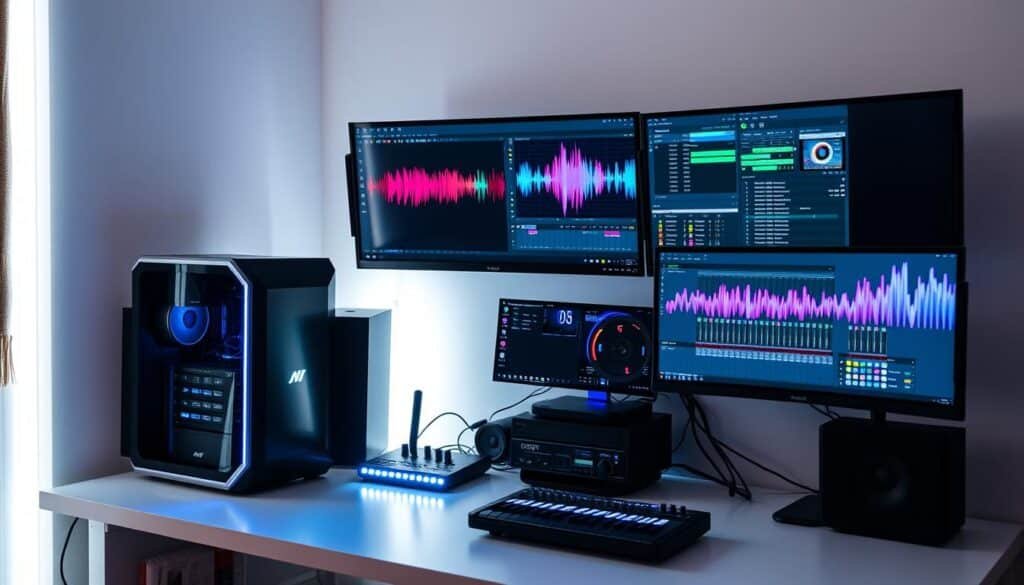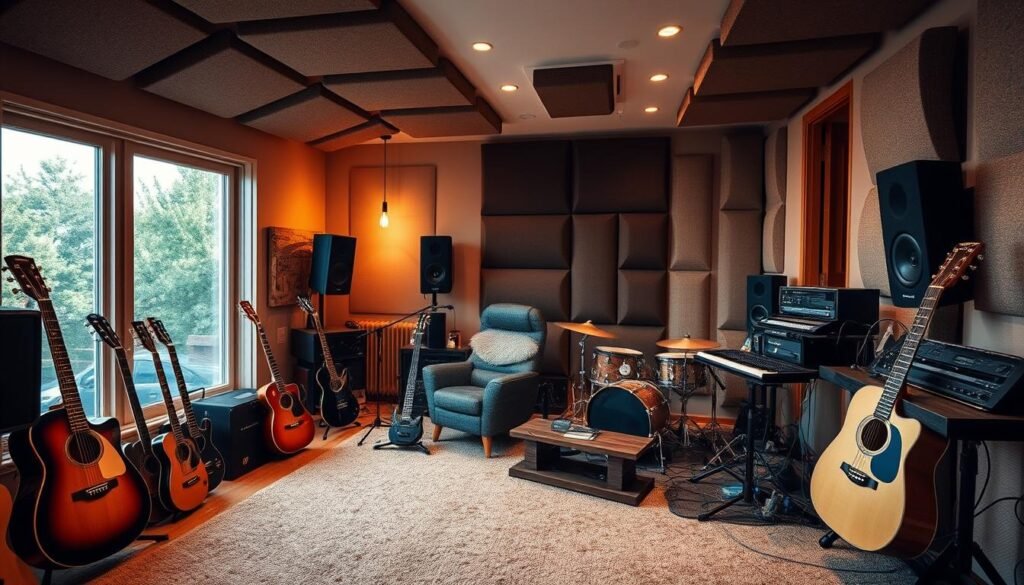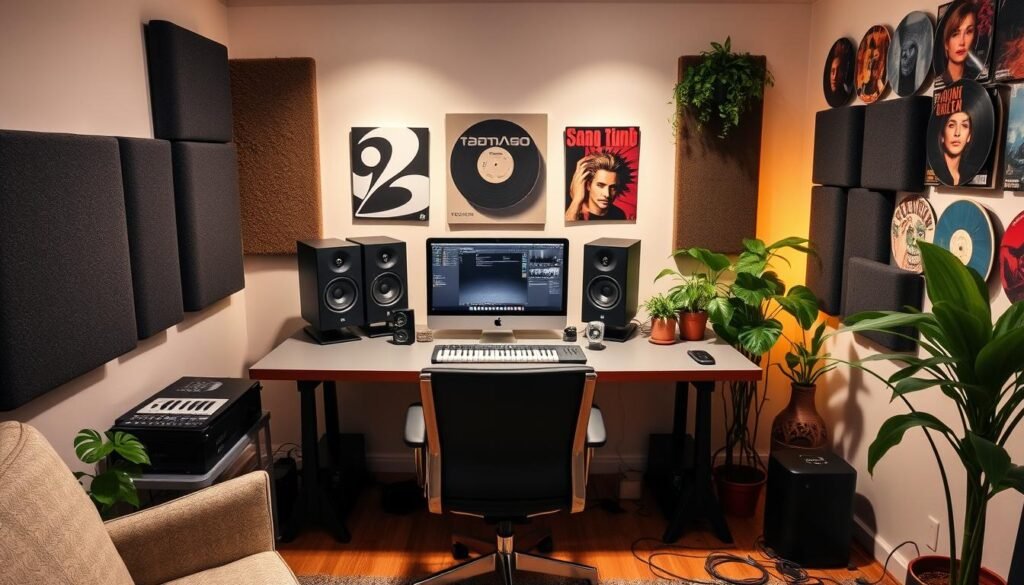How To Set Up A Home Music Studio is easier now thanks to technology. You can now get professional-quality recordings without spending a lot. Start with a realistic budget and get the must-have gear. This guide will help you set up a budget-friendly home music studio. We’ll cover choosing the right computer, audio interface, studio monitors, and acoustic treatment.
Also Read: Music Copyright Rules For Artists: A Guide
Key Takeaways
- Technology has made home music studios more attainable than ever before
- Developing a realistic budget and focusing on essential gear is the key to building a functional home studio
- This guide will cover the steps to create a cost-effective home music studio, including computer setup, audio interface selection, and acoustic treatment
- By following this guide, you can achieve professional-quality recordings in the comfort of your own home
- The guide provides a comprehensive approach to setting up a home music studio, from hardware to software and acoustics
Determine Your Budget and Space
Before starting your home studio, think about what you need and set a budget. The cost of a home studio changes a lot based on your needs and the gear you pick. Decide how you’ll use your studio – for a band or just for solo tracks. This helps you spend wisely and make smart choices.
Also Read: How To Write A Song?
Evaluate Your Needs and Set a Realistic Budget
Think about the music you’ll record, how many tracks you’ll need, and the gear quality you want. A simple setup can be affordable, but high-end gear costs more. Look at your needs and budget to get the best value.
Choose an Appropriate Room for Your Home Studio
The room you pick affects your recording quality. Avoid rooms with low ceilings or square shapes, as they can cause bad sound. Find a big room with high ceilings and little outside noise. Think about size, height, and how you can treat the room for better sound.
| Home Studio Space Requirements | Recommended Room Size |
|---|---|
| Small Home Studio (1-2 musicians) | 150-300 square feet |
| Medium Home Studio (3-4 musicians) | 300-500 square feet |
| Large Home Studio (5+ musicians) | 500-800 square feet |
The size and sound of your studio space greatly affect your recordings. So, take your time to pick a room that fits your needs and budget.
Also Read: Best Music Schools In The USA
Assemble a Powerful Computer Setup

Your computer is the core of your home studio. It handles tasks like recording, playback, and running virtual instruments and effects. When picking a computer for your home studio, you have many options.
Minimum Hardware Requirements for Music Production
To make sure your computer can manage music production tasks, look for these minimum specs:
- 64-bit operating system (Windows 10 or macOS)
- At least 8GB of RAM, preferably 16GB or more
- Multi-core processor, such as an Intel Core i5 or AMD Ryzen 5
- Solid State Drive (SSD) for storage, which gives faster performance
- Integrated graphics with good quality, as a dedicated graphics card is not essential for music production
Cost-Effective Tips: Custom vs. Pre-Built vs. MAC
When building a computer for your home studio, you have a few choices:
- Custom-built PC: Building your own system can save money. It lets you pick components that fit your needs.
- Pre-built systems: These are also an option. But, they might not let you customize as much as a custom-built PC.
- MAC: If you’re thinking about a Mac, be ready for a higher cost. Macs are usually pricier. But, they work well with Apple’s ecosystem and have Logic Pro X DAW.
The choice between a custom-built PC, pre-built system, or a Mac depends on your budget, needs, and what you like. Think about what you need and look into your options to find the best computer for your home studio.
Also Read: Music Theory For Beginners: Start Your Journey
Select an Audio Interface and Studio Monitors

Setting up a home music studio starts with the audio interface. It connects your analog gear like mics and instruments to your computer. Choosing the right audio interface is key to great recordings and studio performance.
Understanding Audio Interfaces and Input/Output Requirements
When picking an audio interface, think about how many inputs and outputs you need. For a basic setup, a 2-input interface might do. But if you’re recording a band or many instruments, you’ll want more inputs. Make sure the interface has enough outputs for your studio monitors and other gear.
The quality of the preamps and converters in an audio interface is crucial. Good preamps boost your sound without adding noise or distortion. Top-notch converters make sure your analog signals turn into clean digital ones.
Also Read: Tips For A Long Term Music Career
| Feature | Importance |
|---|---|
| Number of Inputs | Determines the number of sound sources you can record simultaneously |
| Number of Outputs | Allows you to connect your studio monitors and other audio equipment |
| Preamp Quality | Affects the noise and distortion levels of your recorded sound |
| Converter Quality | Ensures a clean, detailed digital representation of your analog signals |
Think about these audio interface features and input/output requirements carefully. This way, you can pick the perfect home studio audio interface for your needs. It will help you make top-quality recordings at home.
How To Set Up A Home Music Studio

Setting up a home music studio starts with picking the right digital audio workstation (DAW). This software lets you record, edit, and mix your music. There are many DAWs out there, each with special features.
Digital Audio Workstation (DAW) Selection
Choosing the right DAW is key for your home studio. Think about how easy it is to use, what features it has, and if it works with your gear. Top choices for home recording include Pro Tools, Logic Pro, Ableton Live, Cubase, and Reaper. The DAW you pick doesn’t directly affect your recording quality. But, it’s important to pick one that fits your way of working and your creative goals.
Essential Recording Gear: Microphones, Headphones, MIDI Keyboard
You’ll also need some basic gear for great recordings. A quality microphone is vital for recording vocals and instruments. You might want to look at both condenser and dynamic microphones, depending on where you’re recording. Headphones are key for listening back to your tracks and mixes. Open-back headphones give you a clearer sound. And, a MIDI keyboard lets you play and record digital instruments in your DAW, adding more sounds to your music.
| Essential Home Studio Gear | Recommended Options |
|---|---|
| Digital Audio Workstation (DAW) | Pro Tools, Logic Pro, Ableton Live, Cubase, Reaper |
| Microphones | Condenser and Dynamic Microphones |
| Headphones | Open-back Headphones |
| MIDI Keyboard | Integrated MIDI Keyboard |
With the right home studio DAW, microphones, headphones, and MIDI keyboard, you’re set to make top-notch recordings at home.
Acoustic Treatment and Optimization

Proper home studio acoustic treatment is key for a professional home studio. It’s not the same as soundproofing. It’s about controlling how sound moves in the room. This means fixing issues like echo, standing waves, and low-frequency problems.
Using home studio sound absorption and home studio sound diffusion materials helps. These materials make your listening space more consistent and accurate. This lets you make better mixing and recording choices. While you can try DIY options, professional-grade panels work best for top results.
To treat your home studio well, follow these steps:
- Find problem spots: Test the room by clapping your hands to spot echoes and standing waves.
- Focus on bass: Use bass traps in corners to tackle low-frequency issues.
- Add absorption: Put acoustic panels around to cut down on reflections and improve sound control.
- Diffuse sound: Place diffusion panels to spread sound waves and enhance the soundstage.
- Adjust and fine-tune: Keep changing your treatment setup until you get the sound you want.
Putting effort into home studio acoustic treatment greatly improves your recordings and mixes. It boosts your creative process too.
Workspace Setup and Additional Accessories

Creating a great home studio workspace is key for your creative work. It’s not just about the audio gear. The right design choices can boost your productivity and improve your recording experience.
Creating an Inspiring and Functional Recording Environment
Begin with a comfy desk and an ergonomic chair for long recording and mixing sessions. Think about the home studio lighting – it should be adjustable and set the mood. Keep your home studio workspace tidy by organizing your gear for easy access.
Adding cable management solutions, monitor stands, and microphone booms can make your studio better. These items help with home studio organization, making your workflow smoother and reducing distractions.
| Accessory | Benefit | Recommended Products |
|---|---|---|
| Desk and Chair | Comfort and Ergonomics | Herman Miller Aeron, Steelcase Leap |
| Lighting | Mood and Ambiance | Philips Hue, LIFX Smart Bulbs |
| Cable Management | Organized and Tidy Workspace | Cable Sleeves, Cable Trays, Cable Ties |
| Monitor Stands | Proper Viewing Angle and Ergonomics | VIVO, North Bayou Monitor Mounts |
| Microphone Booms | Flexible Microphone Positioning | Rode, Blue Microphones Booms |
By picking the right home studio workspace design and accessories, you can make a space that inspires creativity. This will improve your music production experience.
Also Read: 5 Classical Albums To Listen To Now
Conclusion
Setting up a professional-quality home music studio is easier than ever. Start by thinking about what you need, setting a budget, and picking the right gear. The goal is to make a space that works well and doesn’t cost too much. It’s not about spending a lot of money, but about choosing the right tools for you.
With the right home studio setup guide, you can turn your home into a studio. This way, you can record your music without needing a big commercial studio. Building a home music studio might seem hard, but it’s easier if you take it one step at a time. Focus on making an affordable home recording studio and you can make professional-quality music at home.
Starting a home music studio is exciting. It lets you explore your creativity and improve your skills. By using the tools and technology out there, you can make a space that inspires you. This space will help you create, innovate, and grow as a musician.
FAQs
Q: What do I need to set up a home recording studio?
A: To set up a home recording studio, you will need essential recording equipment such as a computer with recording software like FL Studio, a good audio interface, a pair of studio monitors, microphones for vocal recording, headphones, and a studio desk to organize your space.
Q: How can I build a home recording studio on a budget?
A: You can build a home recording studio on a budget by starting with basic equipment that fits your needs. Look for used gear, prioritize essential items like a quality microphone and audio interface, and consider free or affordable software options for music production.
Q: What is the best space for setting up a music studio at home?
A: The best space for setting up a music studio at home is a quiet area with minimal noise interference. A bedroom studio can be great for recording if treated acoustically, ensuring good sound quality. Consider using soundproofing materials to enhance your recording space.
Q: Do I need expensive studio equipment to produce music?
A: No, you don’t need expensive studio equipment to produce music. Many home studios have achieved great music quality with affordable gear. Focus on understanding your equipment and improving your skills in recording, mixing, and mastering.
Q: What software should I use for recording music on my computer?
A: For recording music on your computer, popular choices include FL Studio, Ableton Live, and Logic Pro. These DAWs (Digital Audio Workstations) offer robust features for recording, mixing, and mastering your audio files.
Q: Can I record music in my home if I’m a beginner?
A: Absolutely! Many beginners successfully set up a home recording studio. Start with basic recording equipment and gradually learn the process of recording music, mixing, and mastering. There are plenty of online resources to help you get started.
Q: What are the key components of home recording studio equipment?
A: The key components of home recording studio equipment include a computer, recording software, an audio interface, microphones, studio monitors, headphones, and a MIDI controller. These tools will help you effectively record music and produce quality audio.
Q: How can I optimize my recording space for better audio quality?
A: To optimize your recording space for better audio quality, consider soundproofing the room, using acoustic treatment panels, and ensuring proper microphone placement. This will help reduce unwanted sounds and improve the overall recording quality.
Q: What should I consider when planning to record music at home?
A: When planning to record music at home, consider the layout of your recording space, the quality of your recording equipment, and your workflow. Make sure you have a comfortable setup that allows for effective recording and mixing sessions.
Source Links
- https://theproaudiofiles.com/setting-up-a-home-studio/
- https://www.soundtrap.com/content/blog/set-up-music-recording-studio-at-home
- https://audient.com/tutorial/building-a-home-studio-on-a-budget/




